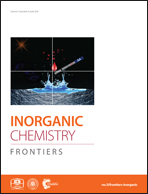[C6H14N]PbI3: a one-dimensional perovskite-like order–disorder phase transition material with semiconducting and switchable dielectric attributes†
Abstract
An organic–inorganic semiconducting compound of 1-methylpiperidinium triiodoplumbate(II) (MPIP), adopting a one-dimensional ABX3 perovskite-like structure, has been synthesized. It is notable that MPIP undergoes a structural phase transition (SPT) at Tc ≅ 202 K, as confirmed by DSC and Cp analyses. Strikingly, MPIP exhibits remarkable switchable dielectric responses; that is, the distinct step-like anomalies in the vicinity of Tc. The switching between high-dielectric and low-dielectric states makes MPIP a potential switchable dielectric material. Single-crystal structural analysis reveals that the most distinct difference between its high-temperature phase (above Tc) and low-temperature phase (below Tc) is the order–disorder transformation of a 1-methylpiperidinium cation, which accounts for its SPT and striking dielectric response. Besides this, MPIP shows semiconducting behaviour with an optical bandgap of ∼2.48 eV, comparable to some other lead-iodide perovskites. The combination of semiconducting and dielectric attributes provides a new perspective for the design of hybrid perovskites as multifunctional materials.
![Graphical abstract: [C6H14N]PbI3: a one-dimensional perovskite-like order–disorder phase transition material with semiconducting and switchable dielectric attributes](/en/Image/Get?imageInfo.ImageType=GA&imageInfo.ImageIdentifier.ManuscriptID=C7QI00722A&imageInfo.ImageIdentifier.Year=2018)


 Please wait while we load your content...
Please wait while we load your content...